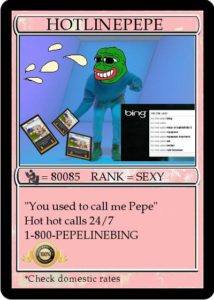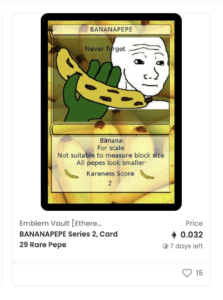The term “meme” comes from the Greek word “mimema,” meaning “imitated.” According to Encyclopedia Britannica, this term was initially introduced in 1976 by British evolutionary biologist Richard Dawkins in his work The Selfish Gene. However, it was not until roughly 2014 when users in the /r9k/ channel of the popular site 4chan began referring to original illustrations and photoshops of Pepe the Frog as “Rare Pepes.” 4chan users would share allegedly “rare” images of Pepe as if they were trading cards, initially on sites like eBay and Craigslist, but eventually, via Counterparty, one of the earliest chains to run on top of Bitcoin, Rare pepes went from meme to movement via the trading of cards and adoption of PepeCash. What is most remarkable about this ecosystem is that it was initiated in 2016/2017, way before most others were at all aware, let alone interested in NFTs.
Fast forward to March of 2022, and Rare Pepes are, in my personal opinion, one of the most undervalued NFT classes on the market. While yes, there have been momentous sales of Nakamoto cards over the past year or so, a treasure trove of OG NFTs from 2016-2018 are currently sitting on opensea for the taking on the Emblem Vault Ethereum account at a floor price of 0.032 ETH. You may be asking, ‘since these were minted on a Bitcoin layer two (for lack of a better term), how can one buy them on Ethereum?

Thanks to the incredible people at Emblem Vault– real counterparty NFTs from the early days of the space have been bridged over to Ethereum and Polygon, and are now accessible for us to buy on Opensea! According to Decrypt: “Emblem Vault is a tokenized multi-asset wallet [that] wraps crypto portfolios into a single NFT token.” So hodlers of OG counterparty NFTs are able to simply and safely bridge their NFTs, such as Rare Pepes, over to ETH, Polygon, and more!
How can you make sure that the NFT you’re buying is authentic? Since these are bridged over, and since we’re in the crypto space here, it’s up to us to do our own due diligence. So every time you buy any NFT from an Emblem Vault account, on Opensea for instance, it’s up to us to check the NFT’s emblem finance and XCP explorer links to ensure that the item we’re buying is a) an Original Rare Pepe (see example here) and b) via the XCP explorer link click on the asset, then click on “issuances” to see how many of a Rare Pepe NFT were originally minted.
While you will notice that there is an abundance of Rare Pepes available on Opensea, not all Pepes are made equal. While I’m not here to give financial advice, it should be obvious to anyone with a background in crypto or NFTs that the most scarce and oldest editions of these NFTs are inherently the most ‘rare.’ With the appropriately named Rare Pepes, rarity varies quite a lot from NFT to NFT. Some pieces come in editions of several million, and if you check them via the XCP explorer, you’ll see that they’re only evaluated at pennies apiece, so in my opinion, not worth buying for even 0.032 ETH.

However, there are NFTs available which are from incredible scarce mint batches of 5000, 3000, 1000, or even a few hundred. Since most of these were minted 5+ years ago on Bitcoin, and only some have been bridged over to ETH or Polygon, most of these collections are lost in a wallet somewhere, and many can’t be claimed. Owning a Rare Pepe from one of these small-batch collections today means that you likely own one of only a few hundred accessible NFTs, the scarcity of these Pepes making them, from my perspective, some of the rarest.
So while you can’t currently get a Nakamoto card for less than 100 ETH as of today, you can still snag some pieces of early NFT history on Opensea that are, in my opinion, still incredibly undervalued. Again, while we don’t give financial advice here, we can delve into the history of NFTs and pinpoint specific projects which we deem important and Rare Pepes are–undoubtedly–one of them. The purpose of this new series is for me to delve into the background of some of the OG NFTs in my collection. In the next article in this series, coming soon, I’ll delve into why I’m currently hodling gen0 CryptoKitties.

